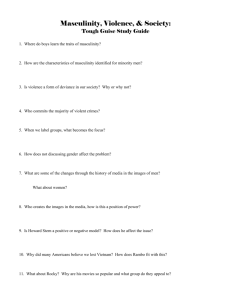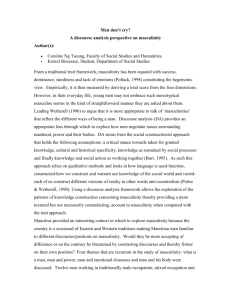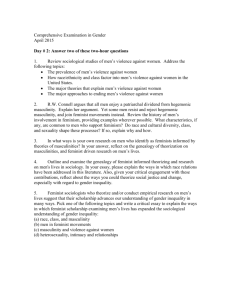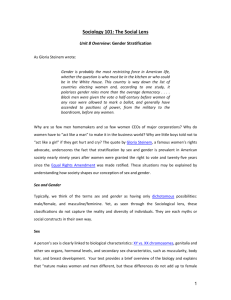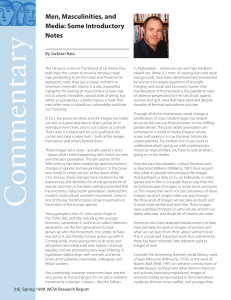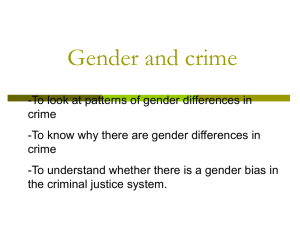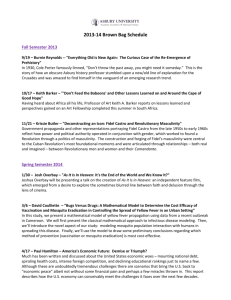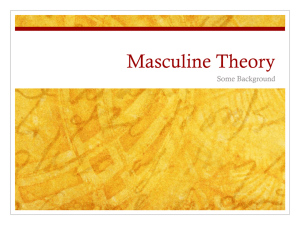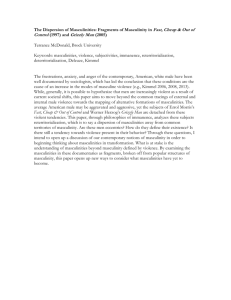Hegemonic Masculinity in Media: Analysis & Representation
advertisement
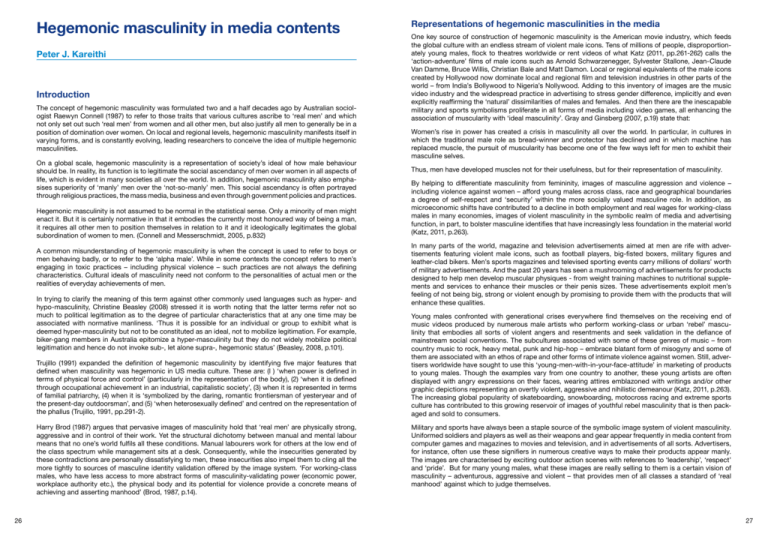
Hegemonic masculinity in media contents Peter J. Kareithi Introduction The concept of hegemonic masculinity was formulated two and a half decades ago by Australian sociologist Raewyn Connell (1987) to refer to those traits that various cultures ascribe to ‘real men’ and which not only set out such ‘real men’ from women and all other men, but also justify all men to generally be in a position of domination over women. On local and regional levels, hegemonic masculinity manifests itself in varying forms, and is constantly evolving, leading researchers to conceive the idea of multiple hegemonic masculinities. On a global scale, hegemonic masculinity is a representation of society’s ideal of how male behaviour should be. In reality, its function is to legitimate the social ascendancy of men over women in all aspects of life, which is evident in many societies all over the world. In addition, hegemonic masculinity also emphasises superiority of ‘manly’ men over the ‘not-so-manly’ men. This social ascendancy is often portrayed through religious practices, the mass media, business and even through government policies and practices. Hegemonic masculinity is not assumed to be normal in the statistical sense. Only a minority of men might enact it. But it is certainly normative in that it embodies the currently most honoured way of being a man, it requires all other men to position themselves in relation to it and it ideologically legitimates the global subordination of women to men. (Connell and Messerschmidt, 2005, p.832) A common misunderstanding of hegemonic masculinity is when the concept is used to refer to boys or men behaving badly, or to refer to the ‘alpha male’. While in some contexts the concept refers to men’s engaging in toxic practices – including physical violence – such practices are not always the defining characteristics. Cultural ideals of masculinity need not conform to the personalities of actual men or the realities of everyday achievements of men. In trying to clarify the meaning of this term against other commonly used languages such as hyper- and hypo-masculinity, Christine Beasley (2008) stressed it is worth noting that the latter terms refer not so much to political legitimation as to the degree of particular characteristics that at any one time may be associated with normative manliness. ‘Thus it is possible for an individual or group to exhibit what is deemed hyper-masculinity but not to be constituted as an ideal, not to mobilize legitimation. For example, biker-gang members in Australia epitomize a hyper-masculinity but they do not widely mobilize political legitimation and hence do not invoke sub-, let alone supra-, hegemonic status’ (Beasley, 2008, p.101). Trujillo (1991) expanded the definition of hegemonic masculinity by identifying five major features that defined when masculinity was hegemonic in US media culture. These are: (l ) ‘when power is defined in terms of physical force and control’ (particularly in the representation of the body), (2) ‘when it is defined through occupational achievement in an industrial, capitalistic society’, (3) when it is represented in terms of familial patriarchy, (4) when it is ‘symbolized by the daring, romantic frontiersman of yesteryear and of the present-day outdoorsman’, and (5) ‘when heterosexually defined’ and centred on the representation of the phallus (Trujillo, 1991, pp.291-2). Harry Brod (1987) argues that pervasive images of masculinity hold that ‘real men’ are physically strong, aggressive and in control of their work. Yet the structural dichotomy between manual and mental labour means that no one’s world fulfils all these conditions. Manual labourers work for others at the low end of the class spectrum while management sits at a desk. Consequently, while the insecurities generated by these contradictions are personally dissatisfying to men, these insecurities also impel them to cling all the more tightly to sources of masculine identity validation offered by the image system. ‘For working-class males, who have less access to more abstract forms of masculinity-validating power (economic power, workplace authority etc.), the physical body and its potential for violence provide a concrete means of achieving and asserting manhood’ (Brod, 1987, p.14). 26 Representations of hegemonic masculinities in the media One key source of construction of hegemonic masculinity is the American movie industry, which feeds the global culture with an endless stream of violent male icons. Tens of millions of people, disproportionately young males, flock to theatres worldwide or rent videos of what Katz (2011, pp.261-262) calls the ‘action-adventure’ films of male icons such as Arnold Schwarzenegger, Sylvester Stallone, Jean-Claude Van Damme, Bruce Willis, Christian Bale and Matt Damon. Local or regional equivalents of the male icons created by Hollywood now dominate local and regional film and television industries in other parts of the world – from India’s Bollywood to Nigeria’s Nollywood. Adding to this inventory of images are the music video industry and the widespread practice in advertising to stress gender difference, implicitly and even explicitly reaffirming the ‘natural’ dissimilarities of males and females. And then there are the inescapable military and sports symbolisms proliferate in all forms of media including video games, all enhancing the association of muscularity with ‘ideal masculinity’. Gray and Ginsberg (2007, p.19) state that: Women’s rise in power has created a crisis in masculinity all over the world. In particular, in cultures in which the traditional male role as bread-winner and protector has declined and in which machine has replaced muscle, the pursuit of muscularity has become one of the few ways left for men to exhibit their masculine selves. Thus, men have developed muscles not for their usefulness, but for their representation of masculinity. By helping to differentiate masculinity from femininity, images of masculine aggression and violence – including violence against women – afford young males across class, race and geographical boundaries a degree of self-respect and ‘security’ within the more socially valued masculine role. In addition, as microeconomic shifts have contributed to a decline in both employment and real wages for working-class males in many economies, images of violent masculinity in the symbolic realm of media and advertising function, in part, to bolster masculine identifies that have increasingly less foundation in the material world (Katz, 2011, p.263). In many parts of the world, magazine and television advertisements aimed at men are rife with advertisements featuring violent male icons, such as football players, big-fisted boxers, military figures and leather-clad bikers. Men’s sports magazines and televised sporting events carry millions of dollars’ worth of military advertisements. And the past 20 years has seen a mushrooming of advertisements for products designed to help men develop muscular physiques - from weight training machines to nutritional supplements and services to enhance their muscles or their penis sizes. These advertisements exploit men’s feeling of not being big, strong or violent enough by promising to provide them with the products that will enhance these qualities. Young males confronted with generational crises everywhere find themselves on the receiving end of music videos produced by numerous male artists who perform working-class or urban ‘rebel’ masculinity that embodies all sorts of violent angers and resentments and seek validation in the defiance of mainstream social conventions. The subcultures associated with some of these genres of music – from country music to rock, heavy metal, punk and hip-hop – embrace blatant form of misogyny and some of them are associated with an ethos of rape and other forms of intimate violence against women. Still, advertisers worldwide have sought to use this ‘young-men-with-in-your-face-attitude’ in marketing of products to young males. Though the examples vary from one country to another, these young artists are often displayed with angry expressions on their faces, wearing attires emblazoned with writings and/or other graphic depictions representing an overtly violent, aggressive and nihilistic demeanour (Katz, 2011, p.263). The increasing global popularity of skateboarding, snowboarding, motocross racing and extreme sports culture has contributed to this growing reservoir of images of youthful rebel masculinity that is then packaged and sold to consumers. Military and sports have always been a staple source of the symbolic image system of violent masculinity. Uniformed soldiers and players as well as their weapons and gear appear frequently in media content from computer games and magazines to movies and television, and in advertisements of all sorts. Advertisers, for instance, often use these signifiers in numerous creative ways to make their products appear manly. The images are characterised by exciting outdoor action scenes with references to ‘leadership’, ‘respect’ and ‘pride’. But for many young males, what these images are really selling to them is a certain vision of masculinity – adventurous, aggressive and violent – that provides men of all classes a standard of ‘real manhood’ against which to judge themselves. 27 Globalisation of masculinity stereotypes • Encouraging institutions of higher learning to intensify interdisciplinary studies in cultural, social, historical, political, psychological, economic and artistic analysis that interrogates the constructions of masculinity in different communities at various times in history. Theorists (Beasley, 2008; Connell and Messerschmidt, 2005) posit that hegemonic masculinities can be analysed at three levels: • Encouraging media educators to develop curricula to instruct future media practitioners – reporters, sportswriters and sportscasters – to avoid language and other symbolisms that maintain the status quo and instead to strive to ‘de-masculinise’ sports and military culture. 1. Local: constructed in the arenas of face-to-face interaction of families, organisations and immediate communities, as typically found in ethnographic and life-history research; 2. Regional: constructed at the level of the culture or the nation-state, as typically found in discursive, political and demographic research; and 3. Global: constructed in transnational arenas such as world politics and transnational business and media, as studied in the emerging research on masculinities and globalisation. • Media industries self-evaluation and improvement: • Encourage media organisations to initiate or support programs to sensitise current media practitioners – working journalists, sportswriters and sportscasters, producers and directors etc. – in recognising and avoiding language, symbols and other representations that perpetuate hegemonic masculinity, especially in writing and talking about sports, war and military matters. There are links between these levels that can be important in gender politics. Global institutions pressure regional and local gender orders; while regional gender orders provide cultural materials adopted or reworked in global arenas and provide models of masculinity that may be important in local gender dynamics. Cornell (2005, p.832) argues that although local models of hegemonic masculinity may differ from each other, they generally overlap. As media conglomerates spread their tentacles in a technologically connected world, the world film-viewing audience is fast becoming more homogeneous. Where audiences appear to prefer locally made fare, the global media corporations have tended to globalise their production. Companies long associated with Hollywood now produce films jointly with local companies in China, France, India and Mexico. India’s acclaimed domestic film industry – ‘Bollywood’ – now has close ties to global media giants. In Africa, the Nigerian film industry, fondly known as ‘Nollywood’, now floods the whole continent with its wares. • Community and non-governmental organisation activism: New technologies have also allowed greater freedom for the media to create highly seductive images that transfix audience attention while avoiding critical interrogation. Social media and other internet-based technologies have increased the media’s powers of replication, amplification and extension of stereotypes of masculinity across the globe. And as media consolidation shapes the uniformity of tastes in some forms of media, it is becoming increasingly clear that some of the once local models of hegemonic masculinity in specific regions of the world have achieved ascendancy on a global scale. References Combating dominant masculinities Some researchers, such as Brown (2012) and Knight (2013), have questioned the wisdom of the long-term use of masculinity as the underlying basis of appeals for military service at a time when women’s role in the military is expanding worldwide. In advertising and recruiting materials, Brown advises that militaries rely less heavily on traditional iconography of a man’s army (emphasis mine) and pay greater attention to international events, references to duty or citizenship and the increasing role of technology. Both stress the need to de-emphasise use of combat imagery that denotes a ‘masculine realm of challenge, excitement, and brotherhood’ in recognition that wars have expanded the military roles of women (Brown, 2012, p.17). Other areas of actions that need to be explored by various actors include: • Public policy: There is still much that governments can do about regulating the amount of violence to which young people, and especially young males, are exposed by better regulating the marketing, broadcasting and/or exhibition of such material to young audiences. Governments should be encouraged to formulate national policies that encourage sporting institutions to be more egalitarian along gender lines. • Encourage and empower local, national, regional and international media associations to lobby governments and media industries for the formulation of policies and production of media contents that de-emphasise representations of dominant masculinities within their jurisdictions. • Empower organisations to design and deliver community and adult education programs in modes of conflict resolution other than use of violence. Beasley, C., 2008. Rethinking Hegemonic Masculinity in a Globalizing World. Men and Masculinities, 11(1), pp.86-103. Brod, H. ed., 1987. The Making of Masculinities: The New Men’s Studies. Boston: Allen & Unwin.Brown, M. T., 2012. Enlisting Masculinity: The Construction of Gender in US Military Recruiting Advertising during the All-Volunteer Force. New York: Oxford University Press.Connell, R. W., 1987. Gender and power: Society, the Person, and Sexual Politics. Cambridge: Polity Press. Connell, R. W., 1995. Masculinities. Berkeley: University of California Press. Connell, R. W. and Messerschmidt, J. W., 2005. Hegemonic Masculinity: Rethinking the Concept. Gender & Society, 19(6), pp.829-859. Consalvo, M., 2003. The Monsters Next Door: Media Constructions of Boys and Masculinity. Feminist Media Studies, 3(1), pp.27-45. Gray, J. J. and Ginsberg, R. L., 2007. Muscle Dissatisfaction: An Overview of Psychological and Cultural Research and Theory. In: J. K. Thompson and G. Cafri, eds. 2007. The Muscular Ideal: Psychological, Social, and Medical Perspectives. Washington, DC: American Psychological Association. pp.15-39. Hanke, R., 1998. Theorizing Masculinity With/In the Media. Communication Theory, 8(2), pp.183–201. Katz, J., 2011. Advertising and the Construction of Violent White Masculinity: From BMWs to Bud Light. In: G. Dines and J. M. Humez, eds. 2011. Gender, Race and Class in Media. Thousand Oaks: Sage Publications. Knight, C., 2013. Gender And Sexuality - Sexuality, Cohesion, Masculinity and Combat Motivation: Designing Personnel Policy to Sustain Capability. Australian Army Journal, Culture edition, 10(3), pp.58-78. Ricciardelli, R., Clow, K. A. and White, P., 2010. Investigating Hegemonic Masculinity: Portrayals of Masculinity in Men’s Lifestyle Magazines. Sex Roles, 63, pp.64-78. Trujillo, N., 1991. Hegemonic Masculinity on the Mound: Media Representations of Nolan Ryan and American Sports Culture. Critical Studies in Mass Communication, 8, pp.290-308. • Scholarly research: • Research work is needed to examine non-fiction, non-entertainment portrayals of men – such as those found in news coverage. Katz (2011) argues that this is especially important given that the criteria for ‘acceptable’ masculinities is likely different in fiction and non-fiction representations of men. • There is a need to identify institutions in society, other than media, where men and boys compete with and put down one another by feminising each other and to design intervention tools. 28 • Curriculum development: 29
